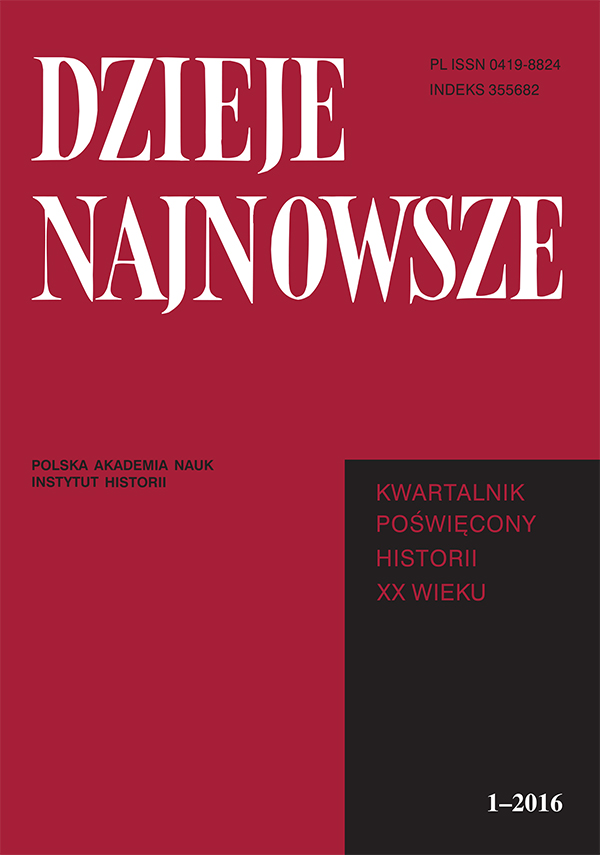Narodowe formacje wojskowe w Rosji bolszewickiej i Związku Sowieckim w latach 1918–1943 i ich rola w polityce ekspansji imperium
DOI:
https://doi.org/10.12775/DN.2016.1.02Słowa kluczowe
Polska Armia Czerwona, Rewolucyjna Rada Wojskowa, wojska gruzińskie, armeńskie, azerbejdżańskie, uzbeckie, kazachskie, turkmeńskie, tadżyckie, kirgiskie, fińskie, korpusy terytorialne RKKA w państwach bałtyckich, 238 Dywizja StrzeleckaAbstrakt
National Military Formations in Bolshevik Russia and the Soviet Union in 1918–1943 and Their Role in the Policy of Imperial Expansion
National military units appeared in Bolshevik Russia already during the so–called October Revolution and predominantly the period known as the “Civil War” or the “Struggle against the Counter–Revolution”. It is highly probable that upon this stage in the history of Bolshevik Russia the existence of such armies was supposed to bolster the self–esteem of the vanquished nations and their elites and to preserve the mistaken conviction that Red Russia respected their right to self–determination and was devoid of imperial or Russification leanings. These armies, based on voluntary recruitment and during the winter even disbanded, resembled rather a Red militia, not to mention a commonplace gang. Nonetheless, the application of a national rhetoric made it easier to conceal the true Bolshevik targets, i.e. the reconstruction and even the expansion of the former tsarist Empire. It seems worthwhile to draw attention to a certain continuum of the Russian/Soviet or Putinesque line pursued by the Russian state and a strategic scheme planned at least decades ahead, regardless of its provenance. Today, the counterpart of the ”national” armies and governments involves ”independent” separatists and their military and political structures as well as long ago devised models of conduct (elections, plebiscites, rhetoric suitable for a presentation of arguments, etc.). Hence an analysis of former military–political conceptions may well serve contemporary objectives.
Bibliografia
Aplebaum A., Za żelazną kurtyną. Ujarzmienie krajów Europy Wschodniej 1944–1956, Warszawa 2012.
Dekriety Sowieckoj Własti, t. I, Moskwa 1957; t. II, Moskwa 1952; t. III, Moskwa 1964; t. IV, Moskwa 1968.
Direktiwy Gławnogo Komandowanija Krasnoj Armii (1917–1920). Sbornik dokumientow, Moskwa 1969.
Istorija wtorowoj mirowoj wojny 1939–1945, t. IV, Moskwa 1975.
Iz istorii wojsk WCzK i pogranicznoj ochrany. Dokumienty i matieriały 1917–1921, Moskwa 1958.
Katyn’. Plenniki nieobjawlennoj wojny, Moskwa 1999.
KPSS o Woorużennych Siłach, Moskwa 1969.
KPSS o Woorużennych Siłach Sowietskogo Sojuza. Dokumienty 1917–1981, Moskwa 1981.
Krymskaja konfierencija rukowoditielej triech sojuznych dierżaw — SSSR, SszA i Wielikobritanii 1–11 fiewralja 1945 g. Sbornik dokumientow, red. A. A. Gromyko i in., Moskwa 1984.
Łubianka. Stalin i Gławnoje uprawlenije gosbiezopasnosti NKWD 1937–1938, Moskwa 2004.
Łubianka. Stalin i NKWD–NKGB–GUKP „Smiersz” 1939–mart 1946, Moskwa 2006;
Pietrow N., Po scenariju Stalina: Rol organow NKWD–MGB w sowietizacii stran Centralnoj i Wostocznoj Jewropy 1945–1953 gg, Moskwa 2011.
liet Woorużennych Sił SSSR, Moskwa 1968.
Sibirskaja Wandieja 1919–1921, t. I: 1919–1920, Moskwa 2000; t. II: 1920–1921, Moskwa 2001.
Sbornik zakonow SSR i ukazow Prezidiuma Wierchownogo Sowieta SSSR, t. I, Moskwa 1968.
god, t. I–II, Moskwa 1998.
Stalinskije dieportacii 1928–1953. Dokumienty, Moskwa 2005.
Wojennaja razwiedka informirujet, janwar’ 1939–ijun’ 1941. Dokumienty, oprac. W. A. Gawriłow, Moskwa 2008.
Wnutriennyje wojska Sowieckoj respubliki (1917–1922). Dokumienty i matieriały, Moskwa 1972.
Zakonodatielnyje i administratiwno–prawowyje akty wojennogo wriemieni, Moskwa 1942.
Pobrania
Opublikowane
Jak cytować
Numer
Dział
Statystyki
Liczba wyświetleń i pobrań: 666
Liczba cytowań: 0



